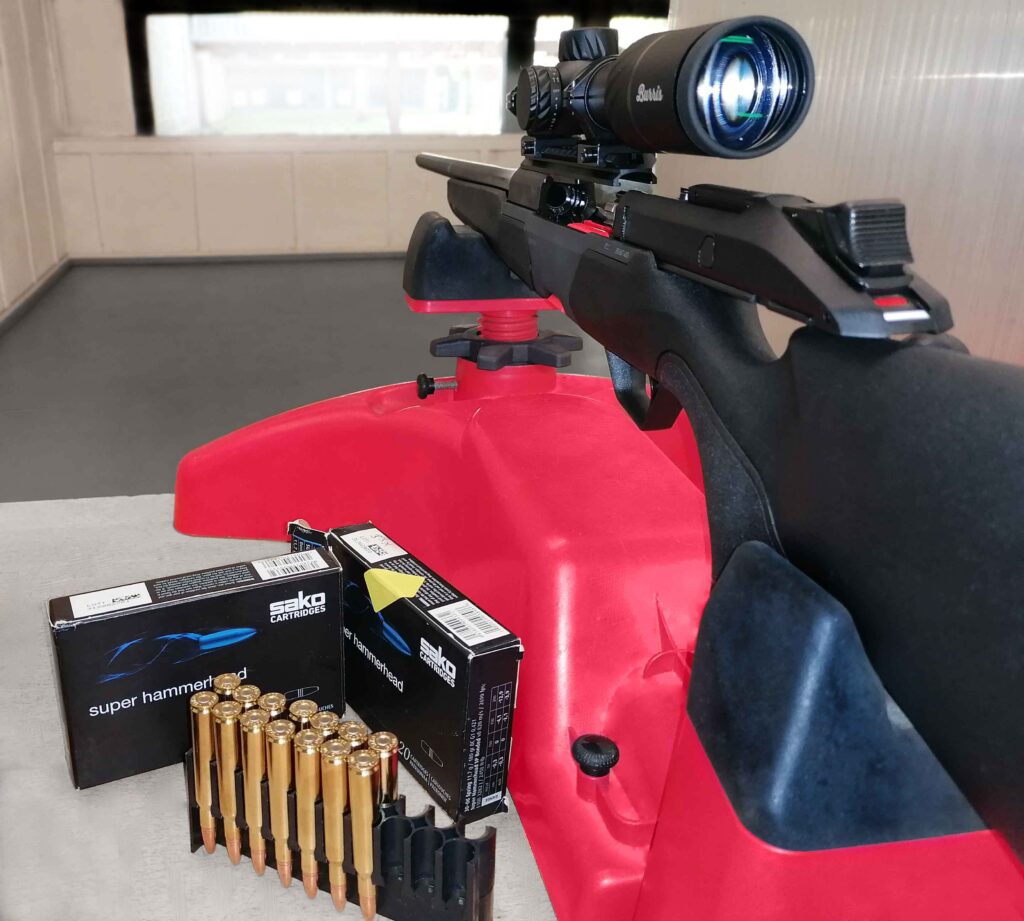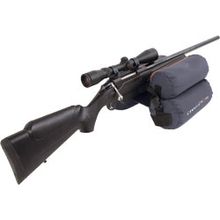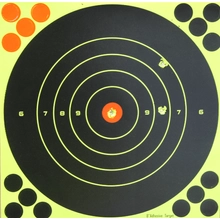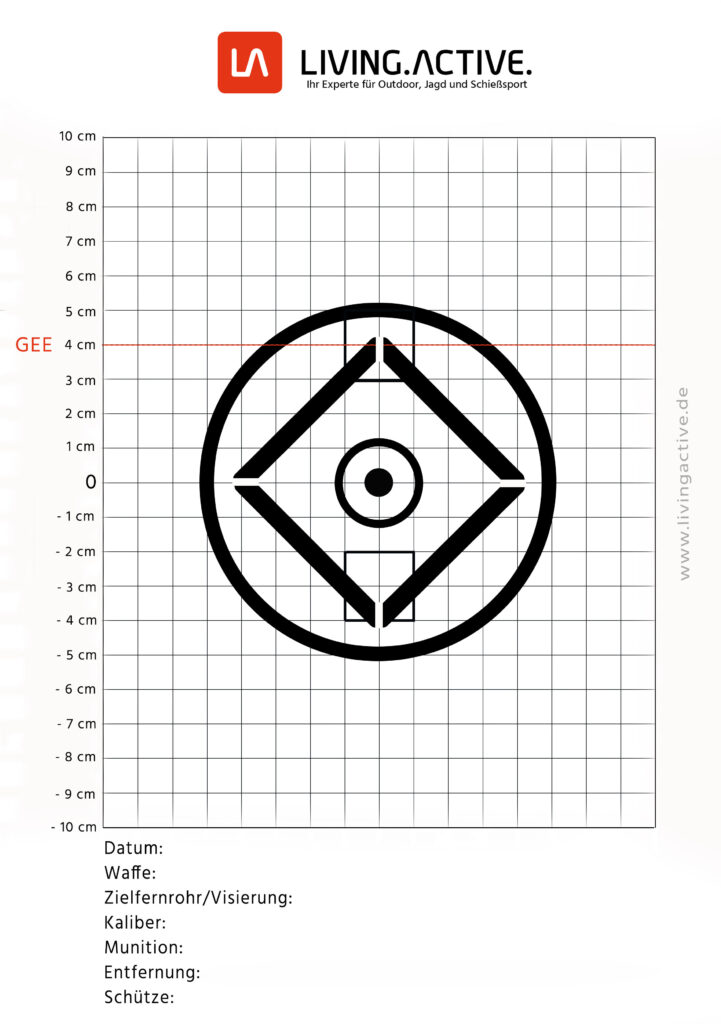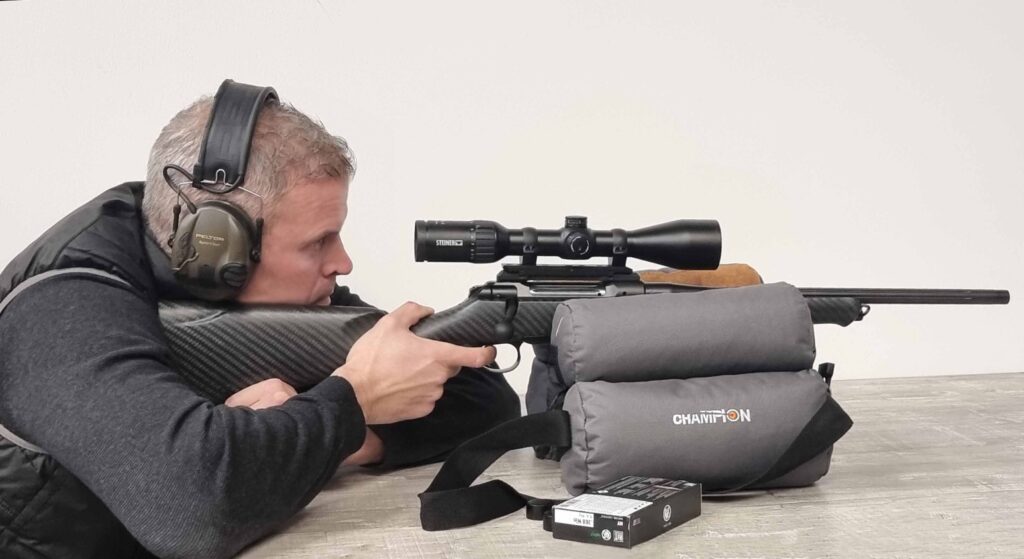Whether a shot actually arrives where it was aimed depends primarily on whether the weapon, sights and ammunition are in “harmony” with each other. Only when these parameters work decently together can the shot be further influenced with the stop, the aiming technique and the trigger technique. However, in order for the weapon, sights and ammunition to function optimally together, they must be adjusted to each other. be In this article, the main focus is on the adjustment of the scope to the weapon, this technique is called “shooting in” and should be part of the basic skills of every user in the hunting field, as well as all other areas in which the scope and weapon are used. Thereby, the shooting in of the scope does not always have to be left to the gunsmith. In the following article, we will explain how to shoot in your riflescope correctly and what you should bear in mind.
When is it necessary to shoot the gun?
When changing to a different type of ammunition, when changing the assembly, during the control shot of the weapon combination, after each change to the three main parameters (rifle, sighting device, ammunition) and also with silencers or muzzle brakes, it must first come to the control shot and with this – if the result is not satisfactory – possibly also to the firing in of the weapon and sighting device.
Implementation of control shots
Location
The control shot should be made on a suitable shooting range, if possible. Here the distance to the target is not too important, 100 m spot or GEE can be performed on a 25 m – or 50 m stand as well as on a 100 m stand. For sights with low magnification or no magnification (red dot sights), a 25 m stand is preferred. Of course, it is also possible for the hunter to carry out the control shot in his own hunting ground (however, the legal regulations must be observed here).
Material needed
- A solid support (sandbag, filled rucksack, shooting stand)
-
Champion Bench Rest Shooting Bags online kaufen auf livingactive.de. Alles für die Jagd ✓ Attraktive Preise ✓ Schneller Versand ✓ Gratis Versand ab 100-,€
Der Champion Bench Rest Schießbeutel wurden entwickelt, um eine perfekte und präzise Platzierung der Waffe zu ermöglichen. Der Schießbeutel ist einer der vielseitigsten im Champion-Sortiment. Er ist ideal für den Jäger und Sportschützen geeign ... weiterlesen
79,95 EURZum Produkt
-
Champion Gorilla Range Bag Sandsack online kaufen auf livingactive.de. Alles für die Jagd ✓ Attraktive Preise ✓ Schneller Versand ✓ Gratis Versand ab 100-,€
Champion Gorilla Range Bag ist halb so groß wie das Original und kann in einer Vielzahl von Formen und Konfigurationen verwendet werden. Diese Schießauflage reduziert den Rückstoß der Waffe und bietet eine erstklassige Stabilität. Sie könn ... weiterlesen
99,95 EURZum Produkt
- Target (preferably single-shot target or target with hit indicator)
-
Fritzmann Zielscheibe mit Trefferanzeige 25 Stück ✓ Schneller Versand ✓ Kauf auf Rechnung ✓ TOP-Preis
Die Fritzmann Zielscheibe mit Trefferanzeige 25 Stück ist selbstklebend. Ideal um sie auf einer Pappscheibe zu befestigen. Die Zielscheibe mit Trefferanzeige eignet sich hervorragend, um die Waffe einfach im Revier einzuschießen, aber auch auf dem ... weiterlesen
24,00 EURZum Produkt
You can also download and use our free LivingActive target:
Other material
- Pin
- Ruler
Stop type
Shooting should be done in the most stable position possible, this would be lying or sitting, preferably at a shooting table. One hand is on the trigger, the other on the forend or buttstock. The butt plate is pulled into the shoulder, both arms resting.
Weapon support
The rifle should rest stably on the forend and buttstock, remaining freely in position so that the reticle is on target even without the shooter. It is important for shooting in the hunting area that the target and the barrel are in the same extension, i.e. that the target is not shot up or down.
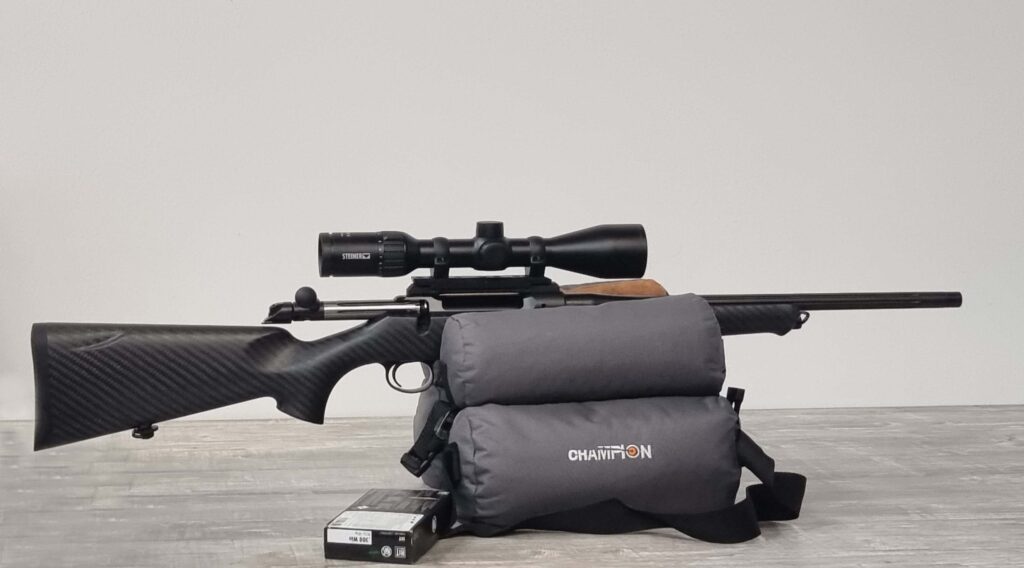
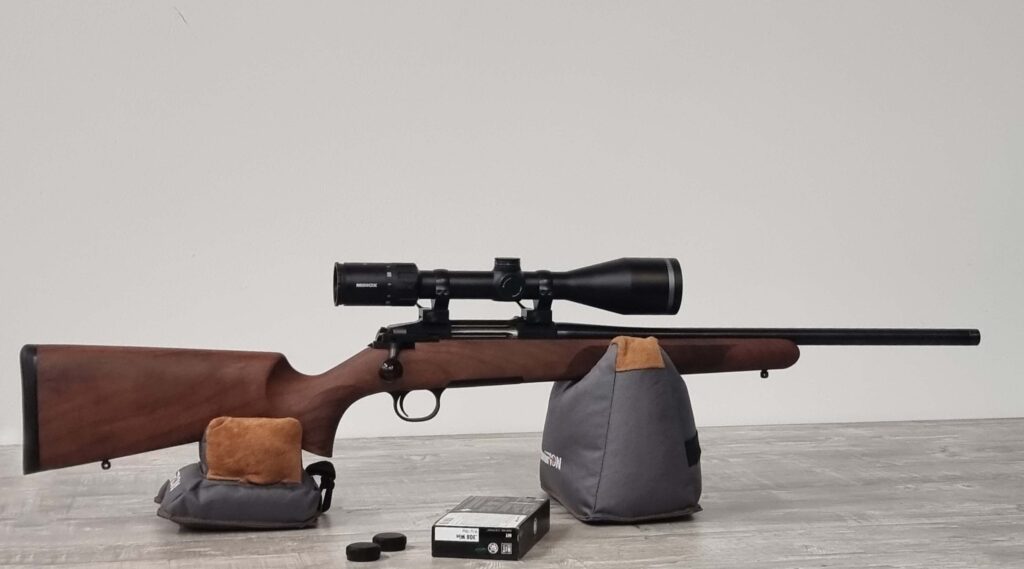
Shoot control group
To determine the instantaneous point of impact of the weapon combination, a control group of min. three or even better five shots fired. To do this, always aim at the same breakpoint and fire the shots of the control group in a calm sequence. If all shots of the group could be fired calmly and without “mucking”, the group is to be evaluated. By using our target, you can repeatedly match different reticles to the same breakpoint and keep the quality of the control group high.
Rate control group
A control group is considered to be good if it has a max. spread of approx. 6 cm (on 50 m/3 cm, 25 m/1.5 cm). If these values cannot be achieved despite the premise that the stop, shooting behavior and agreement were good, something must be changed in the parameters of the weapon, ammunition, sight or attachments.
Adjusting the scope and correcting the point of impact
If the control group is not in the desired target, the stopping point must now be adjusted to the point of impact by adjusting the reticle by the elevation and lateral adjustment of the scope and bringing these points on top of each other. To do this, determine the midpoint position of the control group and measure the distance from it to the breakpoint in the horizontal and vertical planes. Now the determined deviation is set on the adjustment turrets of the scope, elevation turret for the vertical deviation and side turret for the horizontal deviation.
Direction of rotation
You can remember that the point of impact shifts in the direction you turn. So, before the first click, you look at the directional indications on the adjustment towers. If you turn to the right in the direction of the arrow, the point of impact shifts to the right and if you turn up in the direction of the arrow, the point of impact shifts up!
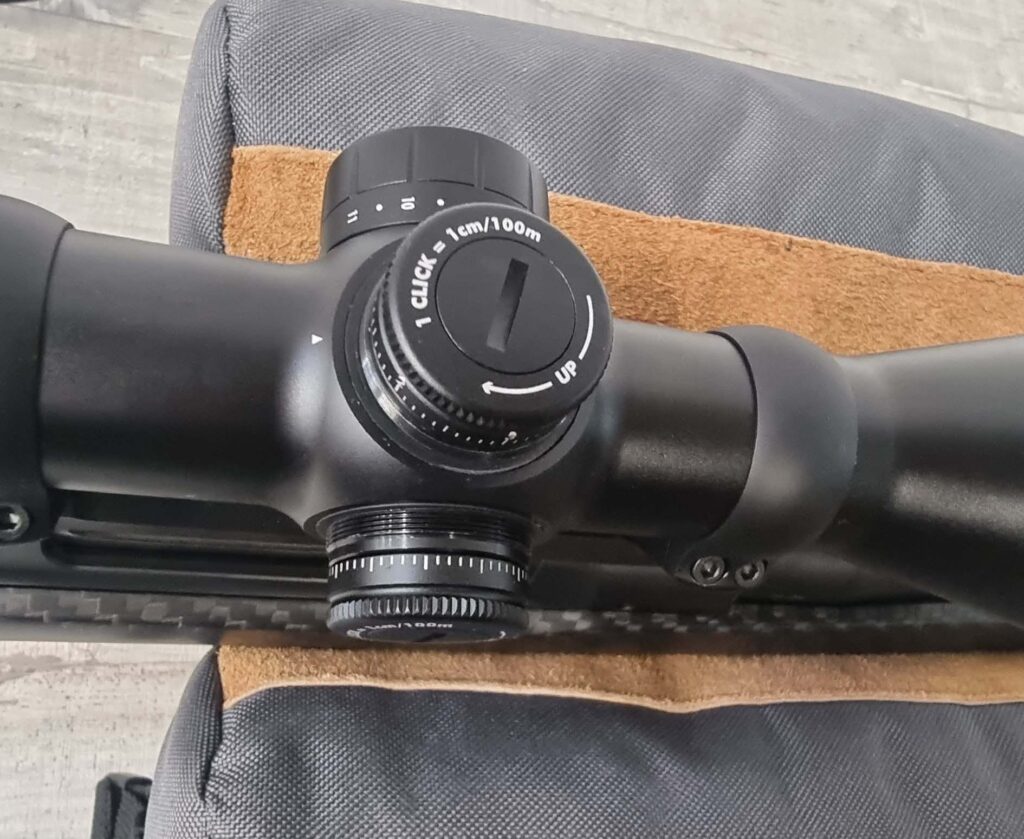
Turning width
Since we know how far we want to shift the hit point position and in which direction it has to be turned, it is important to know how far the hit point position shifts with a click. We should also find this indication on the adjustment towers, which should mostly refer to 100 meters or 100 yards.
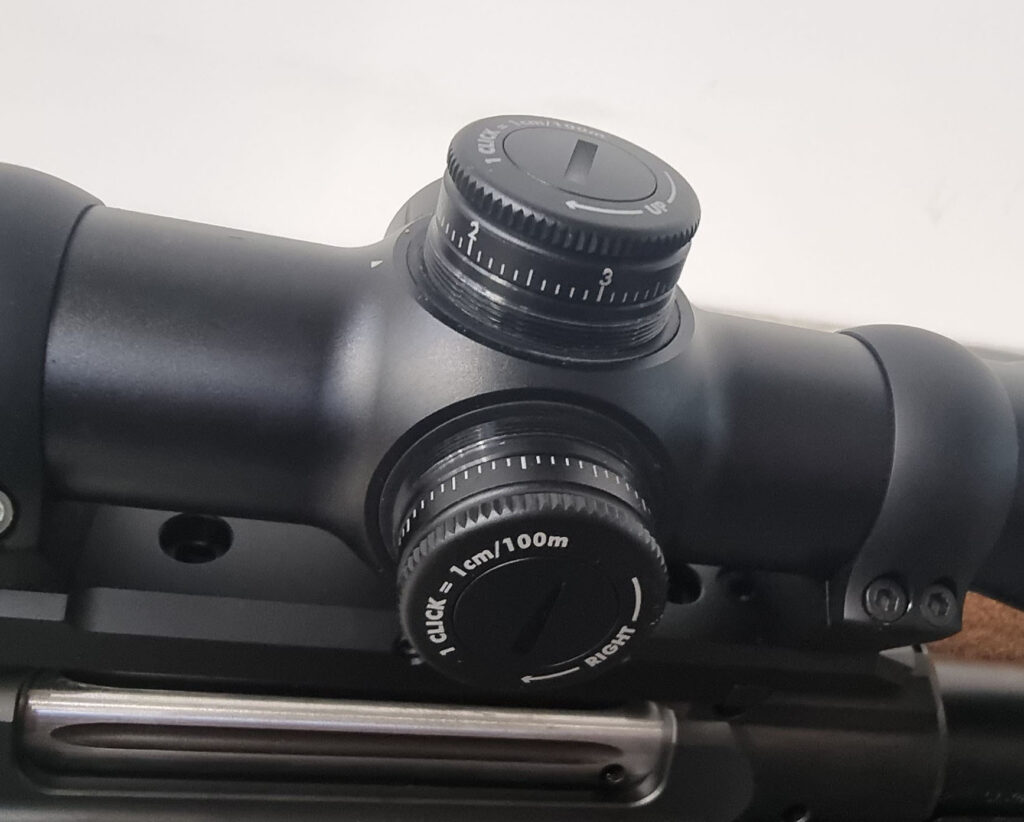
| Scaling | 1 Click = 1 cm/ 100 meters | 1 Click = 1/4 MOA/ 100 meters | 1 Click = 1/8 MOA/ 100 meters |
| Distance: 50 meters | Adjustment: 0.5 cm | Adjustment: 0.36 cm | Adjustment: 0.18 cm |
| Distance: 100 meters | Adjustment: 1 cm | Adjustment: 0.73 cm | Adjustment: 0.36 cm |
| Distance: 150 meters | Adjustment: 1.5 cm | Adjustment: 1.1 cm | Adjustment: 0.55 cm |
| Distance: 200 meters | Adjustment: 2 cm | Adjustment: 1.45 cm | Adjustment: 0.73 cm |
| Distance: 250 meters | Adjustment: 2.5 cm | Adjustment: 1.81 cm | Adjustment: 0.91 cm |
Example 1: The control group is 5 cm high and 3 cm to the right of the hold point, the distance to the target is 100 m. The scope has a click adjustment of 0.1 MRAD = 1 cm/ 100 m. So adjust 5 clicks down and 3 clicks left on the adjustment turrets.
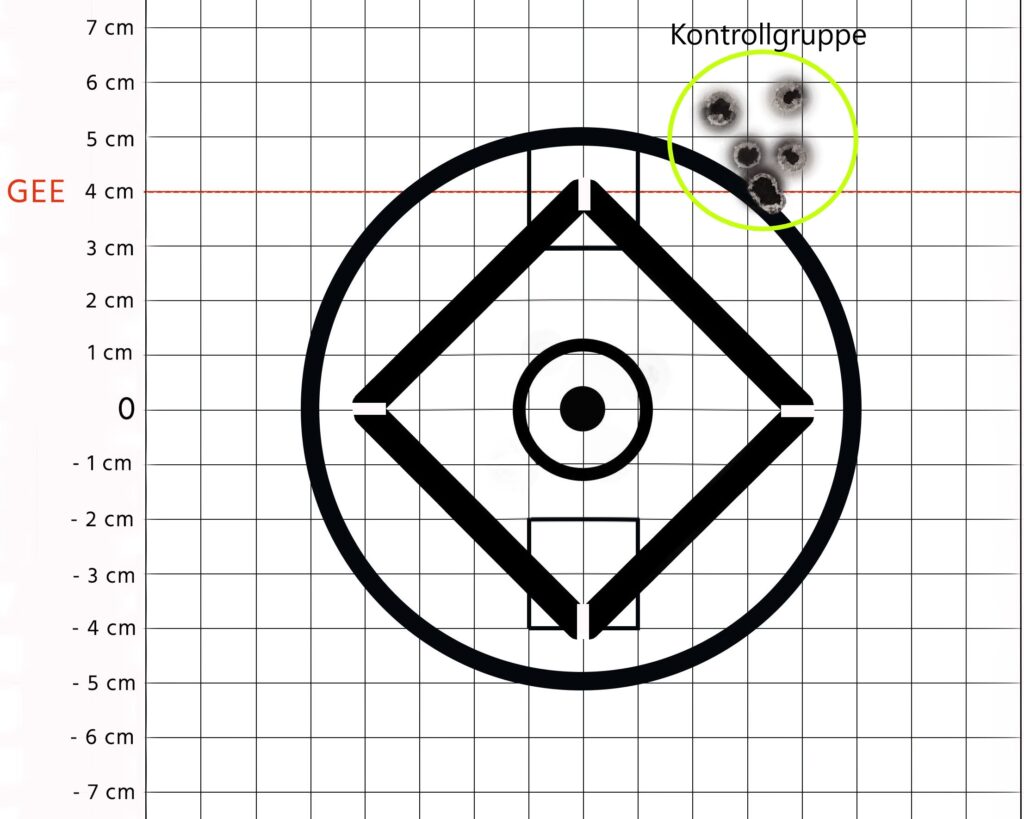
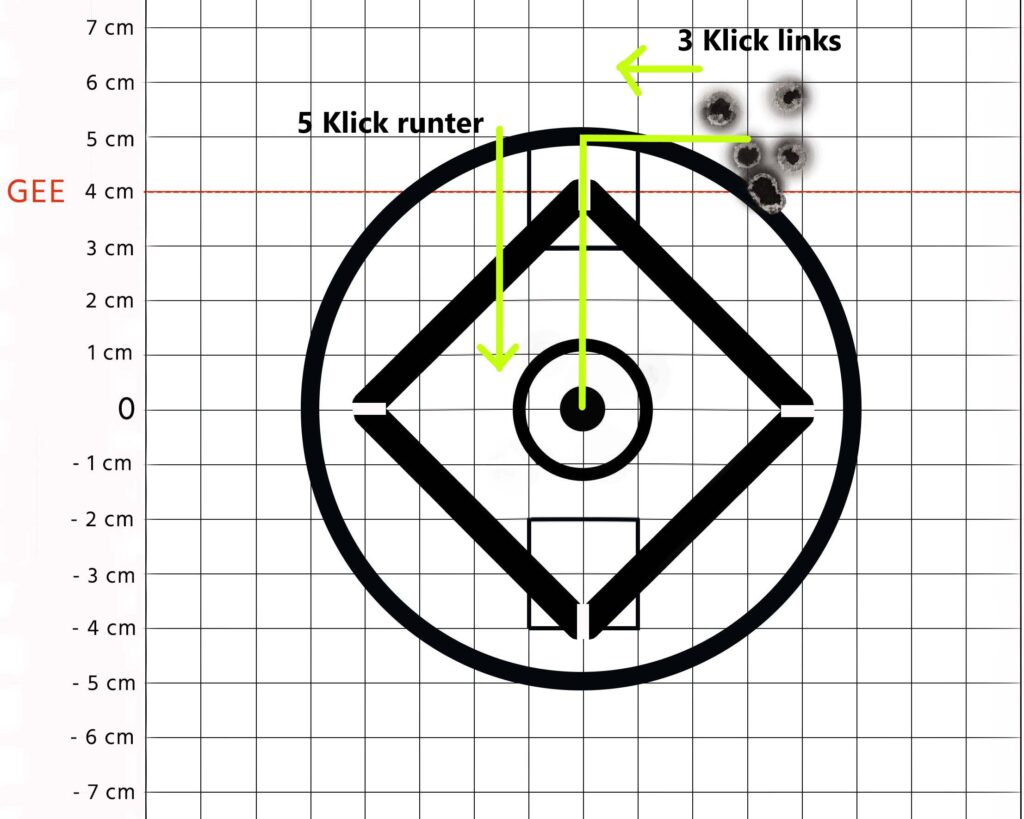
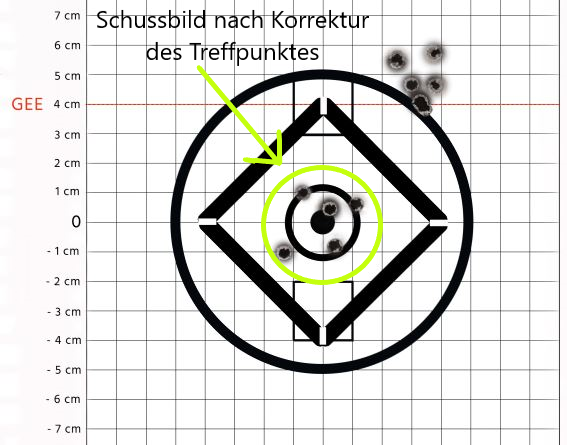
Example 2: The control group is also 5 cm high and 3 cm to the right of the hold point and the target is again at 100 m, but the scope has a click adjustment of 1/4 MOA, which means 0.73 cm/ 100 m. Now divide the deviation by the adjustment range of 0.73 cm to calculate the required number of clicks. Height 5 cm : 0.73 cm = 7 clicks down, right 3 cm : 0.73 cm = 4 clicks to the left. Now another control group is shot, if it is not yet in the desired breakpoint, proceed as described before and repeat the whole process accordingly.
Shooting in at short distances
If the weapon combination is fired at a shorter distance, the number of clicks only needs to be increased in proportion to the target distance. At 50 m x 2 at 25 m x 4. In our example 1 at 50 m: 10 clicks up and 6 clicks right. In example 2 at 25 m: 28 clicks up and 16 clicks right. Before selecting the desired point of impact, it should be noted that due to the curved trajectory of the bullet, the point of impact at different distances will naturally also be different. Spot or GEE at 50 m are not spot or GEE at 100 m or 200 m. In order to correctly select the desired point of impact at the different distances, look at the ballistic data of the selected ammunition, which are usually listed in a table on the cartridge box. Or you can use one of the numerous ballistics apps to get the information you need.
Example: RWS .308 HIT 10.7 g/ 165 grs according to the data sheet with a spot shot at 100 m, the hit point would be 0.5 cm deep at 50 m, 3.8 cm deep at 150 m.
Problems with shooting in – tips and tricks
PROBLEM: First shot not on target Tip: Shorten the distance to 25 m and roughly set the point of impact to low shot 2-4 cm below spot. You can then go back to your desired distance.
PROBLEM: Weapon suddenly scatters Tip: Check scope, mounting for tight fit, check silencer for damage (contact by the bullet).
PROBLEM: Distance to destination not known Tip: If the distance to the target is not known, e.g. in the hunting area, the scope should be adjusted so that the reticle is moved from the aiming point to the point of impact via the adjustment turrets. It is important to ensure that the rifle does not move when turning the adjustment turrets.
Summary
If one of the relevant components of the weapon combination changes, a control shot is necessary in any case. This should be carried out under the best possible conditions, time and rest should be mandatory, so as not to get a false result. If correction is necessary, a bullet target should be used to make it as easy as possible. Even before practical execution, the ranges of adjustment – click adjustments of the sight in relation to the distance – should be clear, so that time and ammunition are saved by failed attempts. Which meeting point is chosen, spot or GEE is up to each person and depends on the needs of the shooter himself. It is important that the weapon combo is well matched together so that the result is usable for the intended purpose. The control shot is not the task of the gunsmith and should be performed by each shooter himself, because the shooter himself is an important part of the weapon combination and from him it also depends significantly on how the hit pattern is. The execution of “shooting in” is always the same, whether air rifle, small caliber or large caliber weapons.

